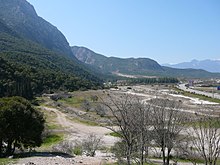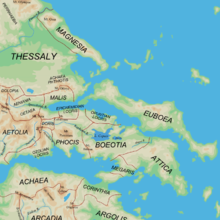Thermopylae


Thermopylae (/θərˈmɒpɪliː/; Ancient Greek and Katharevousa: Θερμοπύλαι (Thermopylai) [tʰermopýlai], Demotic Greek (Greek): Θερμοπύλες, (Thermopyles) [θermoˈpiles]; "hot gates") is a place in Greece where a narrow coastal passage existed in antiquity. It derives its name from its hot sulphur springs.[1] The Hot Gates is "the place of hot springs" and in Greek mythology it is the cavernous entrances to Hades.[2]
Thermopylae is world-famous for the battle that took place there between the Greek forces (notably the Spartans, Lachedemonians, Thebans and Thespians) and the invading Persian forces, commemorated by Simonides in the famous epitaph, "Go tell the Spartans, stranger passing by, That here obedient to their laws we lie." Thermopylae is the only land route large enough to bear any significant traffic between Lokris and Thessaly. This passage from north to south along the east coast of the Balkan peninsula requires use of the pass and for this reason Thermopylae has been the site of several battles.
In ancient times it was called Malis which was named after the Malians (Ancient Greek: Μαλιεῖς), a Greek tribe that lived near present-day Lamia at the delta of the river, Spercheios in Greece. The Malian Gulf is also named after them. In the western valley of the Spercheios their land was adjacent to the Aenianes. Their main town was named Trachis. In the town of Anthela, the Malians had an important temple of Demeter, an early center of the Anthelan Amphictiony.
The land is dominated by the coastal floodplain of the Spercheios River and is surrounded by sloping forested limestone mountains. There is continuous deposition of sediment from the river and travertine deposits from the hot springs which has substantially altered the landscape during the past few thousand years. The land surface on which the famous Battle of Thermopylae was fought in 480 BC is now buried under 20 metres (66 ft) of soil. The shoreline has also advanced over the centuries because of the sedimentary deposition. The level of the Malian Gulf was also significantly higher during prehistoric times and the Spercheios River was significantly shorter. Its shoreline advanced by up to 2 kilometers between 2500 BC and 480 BC but still has left several extremely narrow passages between the sea and the mountains. The narrowest point on the plain, where the Battle of Thermopylae was probably fought, would have been less than 100 metres (330 ft) wide. Between 480 BC and the 21st century, the shoreline advanced by as much as 9 km (5.6 mi) in places, eliminating the narrowest points of the pass and considerably increasing the size of the plain around the outlet of the Spercheios.[3]
A main highway now splits the pass, with a modern-day monument to King Leonidas I of Sparta on the east side of the highway. It is directly across the road from the hill where Simonides of Ceos's epitaph to the fallen is engraved in stone at the top. Thermopylae is part of the infamous "horseshoe of Maliakos" also known as the "horseshoe of death": it is the narrowest part of the highway connecting the north and the south of Greece. It has many turns and has been the site of many vehicular accidents.
The hot springs from which the pass derives its name still exists close to the foot of the hill.

Origin[]
Thermopylae means "hot gates," in reference to the presence of the hot sulphur springs in the area.[1] The cavernous entrance to Hades, the underworld of Greek mythology, was said to be at Thermopylae.[4] In one variation of the story of the Labours of Heracles, it was said that the waters at Thermopylae became hot because the hero Heracles tried to cleanse himself of Hydra poison in them.[5]
The first known Amphictyony, a group of religiously-associated ancient Greek tribes, was centered on the cult of Demeter at the city of Anthela, near Thermopylae. The delegates to this first Amphictiony were dubbed the Pylagorai ("gate-assemblers"); since Demeter had chthonic or underworld associations in many of her older cults, this may be a reference to the gates of Hades.[6]
Battles[]


Greco-Persian Wars[]
Thermopylae is primarily known for the battle that took place there in 480 BC, in which an outnumbered Greek force probably of 7,000[7] (including the famous 300 Spartans, 500 warriors from Tegea, 500 from Mantinea, 120 from Arcadian Orchomenos, 1,000 from the rest of Arcadia, 200 from Phlius, 80 from Mycenae, 400 Corinthians, 400 Thebans, 1,000 Phocians, 700 Thespians, and the Opuntian Locrians) held off a substantially larger force of Persians[8] under Xerxes. Over 1,000 Greeks remained in the pass when most of the army retreated: the survivors from previous fighting of the famous 300 Spartans, the 700 Thespians, and the 400 Thebans - the latter somewhat unwillingly according to Herodotus.[9] Gaius Stern has argued that this force of 1,400 had already suffered casualties of over 100 in the previous fighting, so the true number might be closer to 1,250 than 1,400.[10]
For three days they held a narrow route between hills and the sea against Xerxes' vast cavalry and infantry force, before being outflanked on the third day via an obscure goat path named the Anopaea Pass. According to the Greek legend, a traitor named Ephialtes of Trachis showed the path to the invaders. The following epitaph by Simonides was written on the monument: "Go tell the Spartans, stranger passing by, that here obedient to their laws we lie." (Ὦ ξεῖν', ἀγγέλλειν Λακεδαιμονίοις ὅτι τῇδε κείμεθα, τοῖς κείνων ῥήμασι πειθόμενοι.)
Third Sacred War[]
In 353 BC/352 BC during the Third Sacred War, fought mainly between the forces of the Delphic Amphictyonic League, principally represented by Thebes, and latterly by Philip II of Macedon, and the Phocians. The war was caused by a large fine imposed on the Phocians in 357 BC for cultivating sacred land. The Spartans, who were also fined in that war, actually never fought in it as they were later pardoned.
Gallic invasion of the Balkans[]
In 279 BC a Gallic army led by Brennus initially engaged the Aetolians who were forced to make a tactical retreat and who were finally routed by the Thessalians and Malians by the river Spercheios.
Roman-Seleucid Wars[]
In 191 BC Antiochus III the Great of Syria attempted in vain to hold the pass against the Romans under Manius Acilius Glabrio.
Balkan invasion by the Heruli[]
In 267, the Germanic tribe of Heruli were defeated by a Roman force sent to stop them.
Byzantine-Bulgarian Wars[]
In 997, the Bulgarian Tsar Samuel invaded Greece and advanced as far as the Peloponnese. On his return, he was met by a Byzantine army under Nikephoros Ouranos at Spercheios. As the river was flooded, both sides encamped on opposite sides without action. Confident that the Byzantines could not cross the river, the Bulgarians relaxed their guard and were taken by surprise when Byzantine scouts discovered a ford further upriver.
Greek War of Independence[]
In 1821, a force of Greek fighters led by Athanasios Diakos made a stand near the pass to stop a force of 8,000 Turks from marching down from Thessaly to put down revolts in Roumeli and the Peloponnese. Diakos, after making a last stand at the bridge of Alamana with 48 of his men, was captured and killed.
World War II[]
In 1941 during World War II the ANZAC forces delayed the invading German forces in the area enough to allow the evacuation of the British expeditionary force to Crete. This conflict also became known as the Battle of Thermopylae. Such was the fame of Thermopylae that the sabotage of the Gorgopotamos bridge in 1942 was referred in German documents of the era as "the recent sabotage near Thermopylae".
See also[]
- Battle of Thermopylae
- Battle of Thermopylae in popular culture
- Amphictyonic League
Notes and references[]
- ^ Jump up to: a b "Thermopylae" in: S. Hornblower & A. Spawforth (eds.) The Oxford Classical Dictionary, 3rd ed. (Oxford, 1996).
- ^ L.H. Jeffery (1976) Archaic Greece: The City States c. 700–500 BC. Ernest Benn Ltd., London & Tonbridge p. 73. ISBN 0-510-03271-0
- ^ Rapp, George Robert; Hill, Christopher L. Geoarchaeology: The Earth-science Approach to Archaeological Interpretation, p. 96. Yale University Press, 2006. ISBN 0-300-10966-0
- ^ Croon, J. H. (1952). The Herdsman of the Dead: Studies on Some Cults, Myths and Legends of the Ancient Greek Colonization-area. H. De Vroede.
- ^ Larousse Encyclopedia of Mythology. Prometheus Press. 1959.
- ^ L. H. Jeffery (1976) Archaic Greece: The City States c. 700–500 BC. Ernest Benn Ltd., London & Tonbridge pp. 72-73 ISBN 0-510-03271-0
- ^ Hdt. 7.202 lists the contingents for a total of 4,200; other ancient sources add additional forces: Ephorus apud Diodorus 11.4 adds 1,000 Lacedaemonians - that is Perioeci, likewise Isocrates Paneg. 90, Archid. 99; Ctesias says 900. Ernie Bradford (2004). Thermopylae: The Battle for the West. Da Capo Press, p. 106. ISBN 0-306-81360-2
- ^ Hdt. 7.184-85 lists an army of 2.6 million, of whom he initially specifies 240,000 were soldiers, according to his reckoning, but later says all 2.6 million. See a modern interpretation of Herodotus's estimate, Persian Fire. The First Great Empire and the Battle of the West. New York. Doubleday. p. 394 ISBN 0-385-51311-9
- ^ Hdt. 7.220, 222; Peter Green (1996). The Greco-Persian Wars. University of California Press. p. 140 ISBN 0-520-20313-5
- ^ UC Berk. Ext. class "The Persian Wars" 30 Sept. 2009; "Legends of Marathon and Thermopylae" Lecture at San Jose State 13 Sept. 2010; OSHER/OLLI class "Ten Great Battles of the Ancient World" 24 Oct. 2016;
Further reading[]
- Bradford, Ernie Dusgate Selby (1980). The battle for the West : Thermopylae. New York: McGraw-Hill. ISBN 0070070628. OCLC 5889053.
- Cartledge, Paul (2006). Thermopylae. Overlook Press, New York. pp. 313. ISBN 1585675660. OCLC 71266590.
- Fields, Nic (2007). Thermopylae 480 BC : last stand of the 300. Oxford: Osprey. ISBN 978-1841761800. OCLC 148997192.
External links[]
Coordinates: 38°48′19″N 22°33′46″E / 38.80528°N 22.56278°E
- Battle of Thermopylae
- Hot springs of Greece
- Mountain passes of Greece
- Canyons and gorges of Greece
- Landforms of Phthiotis
- Landforms of Central Greece
- Spa towns in Greece
- Populated places in Phthiotis

